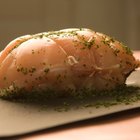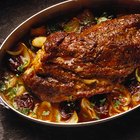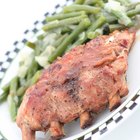Upyanose/iStock/GettyImages
Slow cooking can leave meats rich and tender when it's done properly, but there's always the risk of your cut drying out. That's especially true of leaner cuts such as pork loin or poultry breast, which don't have a lot of fat or connective tissue to help them hold up under long cooking. Brining your pork beforehand is one way to help the meat stand up under longer cooking, yet still retain its moisture.
Get Ready
To make a basic brine, combine 4 quarts of water with 1/2 cup to 1 cup of table salt. If you're using kosher salt, increase the amount by 1/4 to 1/2 cup. Add seasonings, such as maple syrup, brown sugar, white sugar, rosemary, garlic or juniper berries. Heat the brine to boiling and allow it to cool to room temperature. Place the pork in the brine and refrigerate it at 40 degrees F. Refrigerate small cuts of pork for just a few hours. Brine a tenderloin -- which is naturally moist and tender -- for six to 12 hours. Larger roasts can be brined for as long as three days. When you're ready to cook the pork, drain the brine and pat the meat dry -- but don't rinse it, and do not salt the meat. Allow the meat to sit at room temperature for as long as two hours to take the chill off. Meat cooks more evenly and browns better when started at room temperature.
The Slow-Cooker Method
To slow-cook brined pork in a slow-cooker, spray the pot with non-stick cooking spray. Sear the meat in a separate skillet heated over medium-high heat until all sides are golden brown. This step isn't absolutely necessary, but it seals in juices and adds flavor. Place the meat in the slow-cooker and add at least 1/2 to 1 cup of a flavorful liquid, such as apple juice, broth or white wine. Ensure that the meat is partially covered but not submerged. Place the lid on the slow-cooker and cook on low until the pork is very tender. Pork chops and pork medallions cook in two to four hours. Larger roasts need at least six to eight hours.
Serve It Up
Although the USDA recommends 145 F as the minimum internal temperature for cooked pork, you'll probably cook it to a much higher temperature to get moist, tender results. A meat thermometer inserted in the pork should read at least 160 F, and possibly as high as 180 F. Once the meat is done, transfer it to a serving platter or carving board. Tent it loosely with foil and allow it to rest for as long as 30 minutes. Brining gives pork a slightly sweet, slightly salty flavor, depending on the seasonings you use. Shred it for pulled pork sandwiches or roast it with apples, fennel and onions.
Related Articles

How to Braise Pork

How to Cook Marinated Pork Loin From a ...

How to Save Overcooked Pork

How to Cook Beef Top Round Pot Roast

How to Cook Pork Hamonado
How to Slow Cook a Pot Roast With Beef ...

How to Make Pulled Pork In A Slow Cooker

How to Slow-Cook Meat in the Oven

How to Do Corned Pork

How to Make a Juicy Pork Tenderloin

How to Cook Pork Loin

Can You Marinate a Pork Shoulder ...

What Is the Safe Cooking Temp for a ...
How to Cook Brisket Slowly With a ...

How to Use a Roaster for Pork

How to Make a Black Pepper Crust on a ...

How to Cook With Pork Jowl

How to Cook 5 Lbs. of Beef Tenderloin

How to BBQ Ribs on a Smoker

How to Make a Blackbuck Antelope Roast
References
- Fine Cooking: Slow Roasted Pork Shoulder With Salsa Verde
- Not Your Mother's Slow Cooker Cookbook; Beth Hensperger et al.
- Meat: A Kitchen Education; James Peterson
- Epicurious: Maple-Brined Pork Roast With Apples, Onions and Mustard Breadcrumbs
- What's Cooking America: Brining Pork
- The Kitchn: Cooking Tip: Quick Brine for Pork Chops
- USDA: Fresh Pork From Farm to Table
Writer Bio
Julie Christensen is a food writer, caterer, and mom-chef. She's the creator of MarmaladeMom.org, dedicated to family fun and delicious food, and released a book titled "More Than Pot Roast: Fast, Fresh Slow Cooker Recipes."